Your rhomboids are the heroes of upper back strength.
I have seen many clients come to me with rounded shoulders, chronic upper back pain, and persistent tightness between their shoulder blades.
The culprit? Weak, neglected rhomboid muscles.
These small muscles are essential for proper posture, shoulder function, and overall back health. When you’re weak, everything from your deadlift form to your daily activities is affected.
In this comprehensive guide, I will describe the 20 best rhomboid exercises, how to train them, and workout routine.
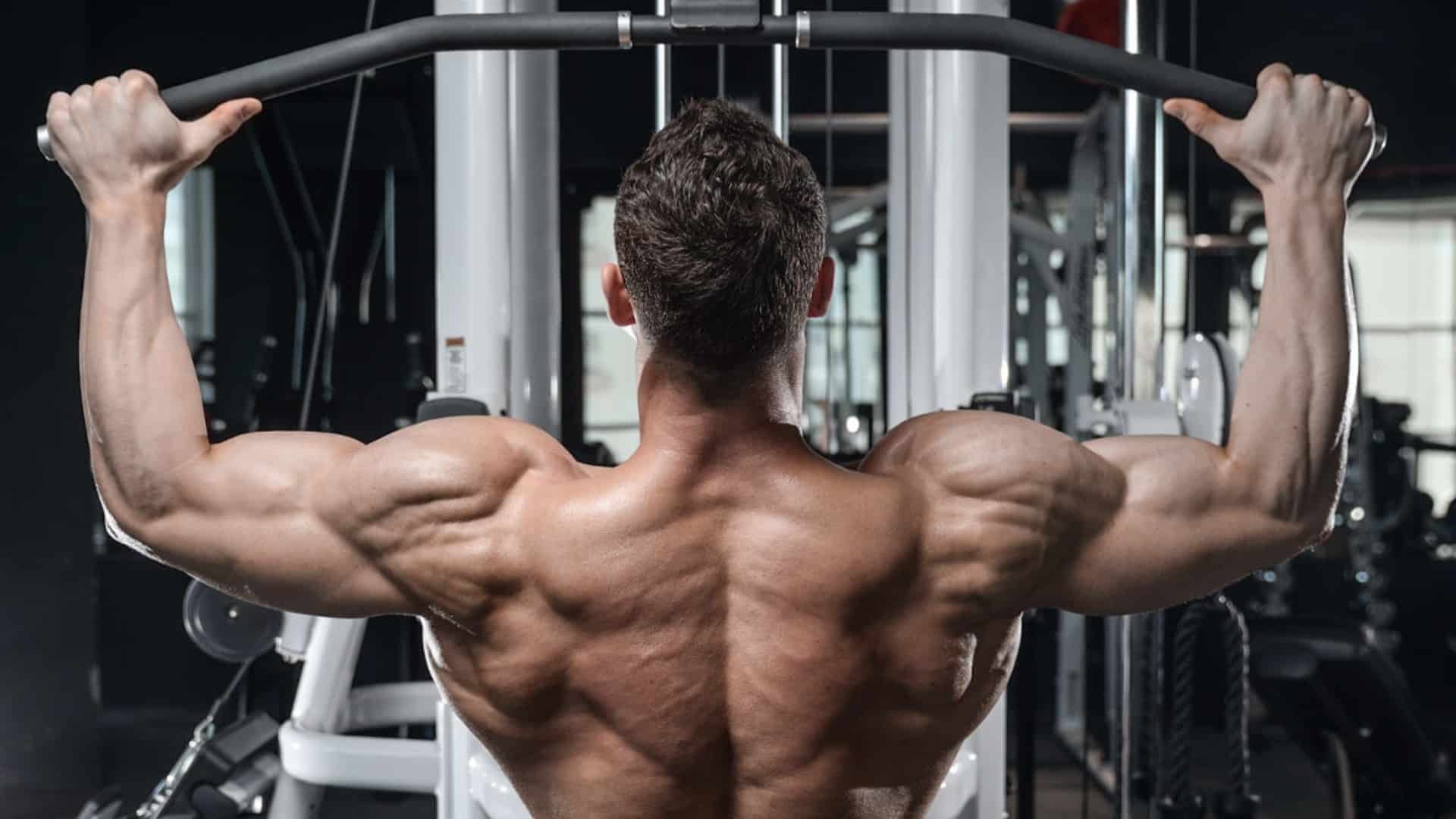
- How to Train Rhomboid Muscles
- 20 Best Rhomboid Exercises for a Stronger Back
- 1. I, Y, T, W
- 2. Inverted Row
- 3. Scapular Push-Ups
- 4. Bent Over Dumbbell Lateral Raise
- 5. One-Arm Dumbbell Row
- 6. Dumbbell Bent Over Row
- 7. Bent Over Barbell Rows
- 8. T Bar Row
- 9. Machine Rear Deltoid Fly
- 10. Reverse Cable Crossover
- 11. Face Pull
- 12. Cable High Row
- 13. One-Arm Lat Pulldown
- 14. Seated Cable Row
- 15. V-Grip Lat Pulldown
- 16. Cable Twisting Standing Row
- 17. Bent Over Rows with Resistance Bands
- 18. Resistance Bands Lats Pulldown
- 19. Resistance Band Seated Row
- 20. Resistance Bands Pull Apart
- Workout Plan and Techniques To Train Rhomboid Muscles
- Beginner Rhomboid Workout Plan
- Bodyweight Rhomboid Workout Plan
- What is the Rhomboid Muscle
- Function of the Rhomboid Muscle
- FAQs
- 1. What causes weak rhomboids?
- 2. Rhomboid Exercises For Posture
- 3. Rhomboid exercises for kyphosis
- References
How to Train Rhomboid Muscles
Do you know that you can target your rhomboids when you do Row, rear fly and pull-ups, or any pulling exercise? But here’s the thing: Why don’t numerous people target their rhomboids effectively?
A primary reason is often using too much weight. When the load is excessively heavy, the body naturally recruits larger, stronger muscles (like the lats and biceps) to move the weight, often at the expense of proper form.
It’s important to focus on scapular retraction—pulling your shoulder blades back and together. Many of us skip this step; without that squeeze, our rhomboids don’t get the workout they need.
So, the best way to train your rhomboid are:
- Perform the exercise through a full range of motion.
- Actively engage your shoulder blades by pulling them back and together (scapular retraction) at the peak of the contraction.
Research has shown that this technique significantly increases the activation of the rhomboid muscles during exercises compared to just pulling the weight without the focused squeeze.
20 Best Rhomboid Exercises for a Stronger Back
Let’s get into the best rhomboid strength and hypertrophy exercises using various types of fitness equipment, such as barbells, dumbbells, cable machines, resistance bands, and some bodyweight rhomboid exercises.
We have created the Rhomboid exercises in many sections, such as:
- Bodyweight Exercises at Home (No Equipment).
- Rhomboid Exercises with Dumbbells.
- Barbell & Machine Exercises
- Rhomboid Exercises with Cables.
- Exercises with a Resistance band.
1. I, Y, T, W
These exercises focus on the shoulder and back muscles, mainly the middle and lower part of the trapezius.
They also hit all the rotator cuff muscles, including the rhomboid, infraspinatus, subscapularis, teres minor, and supraspinatus muscles.
These work together to stabilize the shoulder and move the arm. They are my favourite exercises for working on the rhomboid muscle.
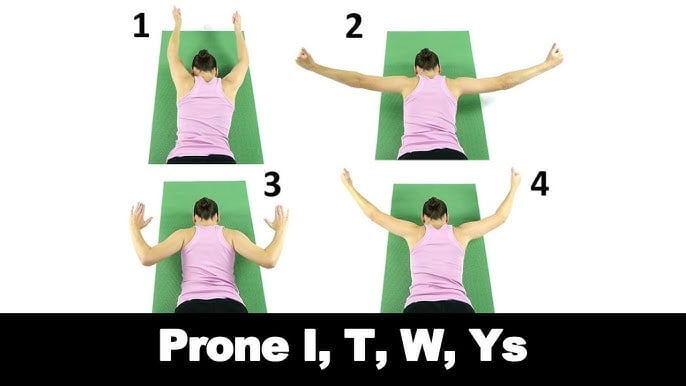
How to Do
- Lay your stomach flat on the ground with your arms and legs fully extended.
- Point your toes away from your body and stretch your elbows and fingers fully.
- Brace your abdominal muscles to stabilise your spine.
- Depress and retract your scapulae (pull your shoulders back and down).
- And attempt to hold these positions (I, Y, T, W) for 5 – 10 seconds.
- Align your head with your thoracic (upper) spine.
Tips
- For the first time, try holding for only five or 10 seconds, and work up to 30 seconds in future workouts.
- Move your arms slowly up and down in each position of I, T, Y, and W.
- Add a 1-3 pound weight in each hand to increase the difficulty for either version.
2. Inverted Row
The Inverted Row (bodyweight rows primarily targets the rhomboid major and minor. It also engages the middle and lower trapezius, latissimus dorsi, posterior deltoids, biceps brachii, and core muscles, including the rectus abdominis and glutes.
It also works the back and shoulder muscles from a different angle and improves scapular retraction.
Most people do this exercise on the Smith machine in the gym, but you can also perform it at home by lying under a chair, holding the chair’s sides, and pulling yourself up.
If you are beginning, bend your knees and keep your feet flat on the ground to reduce the load.
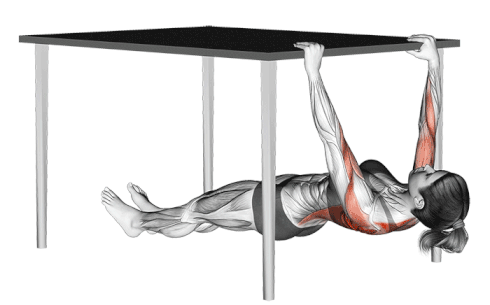
How To Do
- Adjust the height of the chair and bar so that it’s a little higher than arm’s length from the floor.
- Lie under the bar with your legs and body straight.
- Grasp the bar with an overhand grip that’s a little wider than shoulder width.
- Hang with your arms fully extended. Your body should be straight from head to heels (or head to knees if bent).
- Exhale as you pull your chest up towards the bar. Pull until your chest touches or comes close to the bar. At the top, really focus on squeezing your shoulder blades together.
- Keep your legs and body straight, and exhale while you pull your chest to the bar.
- Hold for a count of two and squeeze your Rhomboid muscles.
- Inhale as you lower your body until your arms and shoulders are fully extended. Repeat.
3. Scapular Push-Ups
Scapular push-ups are a variation of regular push-ups that help train the rhomboid and mid-trap muscles.
This isn’t a regular push-up where you bend your elbows. This small, controlled movement has HUGE implications for your shoulder health, posture, and ability to perform all other upper body exercises safely and effectively.
It places greater activity on your rhomboids and serratus anterior muscles than the traditional push-up.
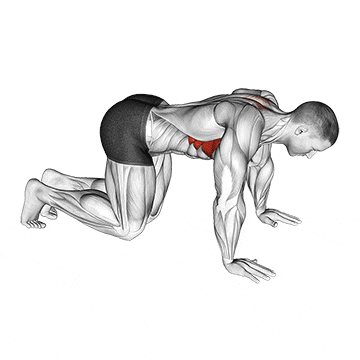
How To Do
- Get into a high plank position with your feet hip-width apart and your hands underneath your shoulder-width apart.
- Let your chest drop between your arms so your shoulder blades retract. Use a small range of motion; do not lower your chest all the way to the floor.
- From here, push through the palms of your hands slowly and round through your back to a protracted position.
- You will feel your shoulder blades spread apart.
- Then repeat: slowly go down and up. Be sure to breathe in on the way down and out on the way up.
4. Bent Over Dumbbell Lateral Raise
The Bent Over Dumbbell Lateral Raise is an isolation exercise that primarily targets your rear deltoids (the back of your shoulders) while giving your rhomboids and trapezius a solid workout during scapular retraction.
You can perform this exercise in both a standing and a seated position. I prefer the seated version, as it requires strict movement.
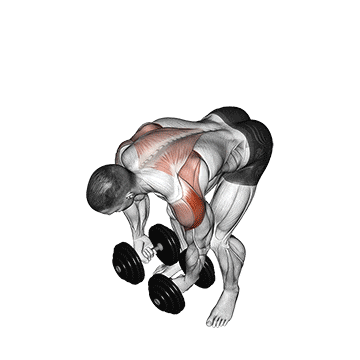
How To Do
- Grab a dumbbell in each hand with a neutral grip (palms facing your body). Stand with your feet hip-width apart, knees slightly bent.
- Hinge forward at your hips, keeping your back straight. Imagine trying to touch the wall behind you with your tailbone.
- Your torso should be roughly parallel to the floor, or as close as your flexibility allows without rounding your back.
- Keep a slight bend in your elbows and lift the dumbbells out to the sides in a controlled arc. Your arms should move perpendicular to your torso.
- At the top of the movement, when your arms are roughly parallel to the floor (or slightly higher if your mobility allows without shrugging), really focus on squeezing those shoulder blades together.
- Slowly and under control, lower the dumbbells back to the starting position.
5. One-Arm Dumbbell Row
The one-arm dumbbell row is an excellent full-range exercise to build the lat and rhomboid muscles.
This helps to work on each side independently, thus providing better muscle isolation and a longer range of motion.
I program this for almost all my clients because it stabilises the core and allows you to focus on one side at a time.
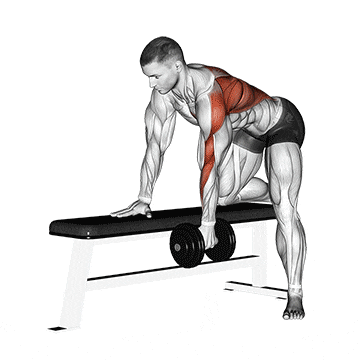
How To Do
- Grab a dumbbell (start with 10–20 lbs for beginners) and place your righy hand and knee on a flat bench for support.
- Your left foot stays on the floor, creating a stable base. Keep your back flat, parallel to the bench, and let the dumbbell hang straight down in your right hand, palm facing inward.
- Engage your core and pull the dumbbell toward your hip. Focus on squeezing your shoulder blade back toward your spine as you row, feeling your rhomboids fire up.
- Hold the top position for a split second to maximise the squeeze, then lower the dumbbell slowly to a full stretch.
- Complete 8–12 reps on one side, then switch to the other arm. Do 2–3 sets per side, resting 60–90 seconds between sets.
6. Dumbbell Bent Over Row
If you want to strengthen the upper back and add massive muscle to the upper back region, then bent-over dumbbell rows are the best exercise.
- Pulling the dumbbell up higher toward the chest targets the upper latissimus and trapezius.
- Pulling the dumbbell through a lower trajectory to touch the abdomen targets the lower lats.
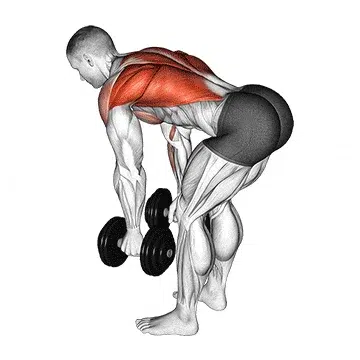
How To Do
- Stand with a narrow stance and a dumbbell with a neutral grip in each hand.
- Do not use more weight than you can handle. This fatigues your spinal erectors and says goodbye to form.
- Bend your torso forward at an angle of 45 degrees to the floor with your knees slightly bent.
- Now, use the back and raise the dumbbell until it touches the abdominal region and not the chest region, as it reduces back muscle contraction.
- Slowly lower the dumbbell and keep it in control of the starting position.
7. Bent Over Barbell Rows
The bent-over barbell row is a compound exercise that strengthens the back. It also engages other muscles like the biceps, lower back, and core to a lesser extent.
The rhomboids are responsible for squeezing the shoulder blades together and pulling them down and back.
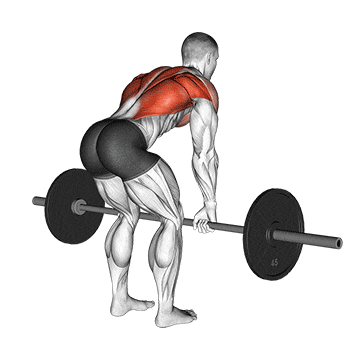
How To Do
- Stand with your feet shoulder-width apart and the barbell on the floor in front of you.
- Bend at your hips and knees to grab the barbell with an overhand grip, hands slightly wider than shoulder-width apart.
- Keep your back straight and your core engaged.
- Your head should align with your spine, and your eyes should look down at the floor.
- Exhale and row the barbell up towards your chest, using your elbows and upper back muscles.
- Pause at the top of the movement and squeeze your shoulder blades together.
- Slowly lower the bar under control to the starting position.
8. T Bar Row
The T-Bar Row is a great way to build back muscle, improve your pulling power, and strengthen the muscles that pull your shoulders back, your rhomboids, and your middle traps.
- The latissimus dross is a primary driver, doing shoulder extension and adduction to bring the load towards your body.
- Rhomboids and middle trapezius are active synergists here, and are responsible for scapular retraction.
It allows for heavy loading, but only if you can keep perfect form.
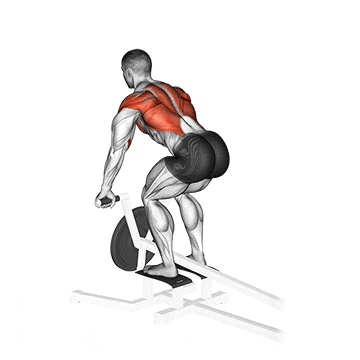
How To Do
- Standing on a T-bar machine, grab its handles with an overhand grip.
- Make sure you use a weight that allows you to have a full range of motion.
- Keep your feet a bit apart and knees slightly bent.
- Bend at the hips and keep your back arched throughout the movement.
- Lift the bar up until the bar touches your chest. Keep your back straight.
- Now, slowly lower the bar until it nearly touches the ground.
9. Machine Rear Deltoid Fly
The machine rear delt fly, or reverse pec deck fly, is a simple yet effective exercise that increases deltoid and back muscle definition and strength.
The pec deck rear delt machine fly targets your upper back muscles and shoulder muscles, particularly the rear deltoids (backside of your shoulders), Traps, and rhomboid.

How To Do
- Adjust the seat height so the handles align with the middle of your chest.
- Sit facing the machine with your chest against the pad. This position pre-stretches the rhomboids, creating optimal length-tension relationship.
- Grasp the handles with a neutral grip (palms facing each other). This grip orientation maximises the contribution of the rhomboids while minimising rotator cuff stress.
- Before moving the weight, retract your scapulae slightly to pre-activate the rhomboids.
- Pull the handles in a wide arc until your arms are fully extended to the sides.
- At full extension, intensify the squeeze between your shoulder blades for 2-3 seconds
10. Reverse Cable Crossover
During reverse cable crossover, your arms should move directly back (and downward slightly), almost parallel to the floor, to target the posterior deltoid.
If the hands are raised through a higher arc to a point above shoulder level, the trapezius, rhomboids, and lateral deltoids contribute more to the movement.
Crossing your hands over one another (uncrossing the cables) at the start position increases the range of motion.

How To Do
- Stand in the center of a cable crossover apparatus.
- Start with hands crossed in front of you at shoulder height, with the left high cable in your right hand and the right in your left hand.
- Pull your elbows out and back as far as possible using your rear delts.
- Then, slowly return to the starting position.
- Do 8–12 Reps of 3–4 sets
11. Face Pull
Often overlooked or performed incorrectly, the face pull is one of the most valuable exercises you can do. It directly targets muscles responsible for externally rotating your shoulder joint and pulling your shoulder blades back.
The face pull is a multi-joint movement that involves several actions at the shoulder girdle.
- Your Rhomboids and Middle Trapezius contract to pull your shoulder blades together towards your spine against the resistance.
- Your Posterior Deltoids are working to pull your arms back in the horizontal plane.
- The Infraspinatus and teres minor (part of the rotator cuff) specifically work to rotate your upper arm outwards as you pull the rope towards your face and finish the movement.
It is one of my favorite exercises that I use to train and build strong rhomboid muscles after a back workout.
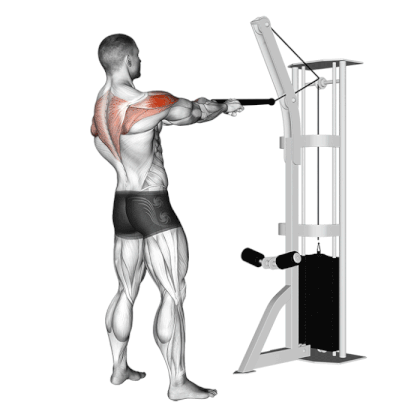
How To Do
- Set the cable pulley height to about head level or slightly above.
- Take the rope attachment with an overhand grip (palms facing down) and place your thumbs against the ends of the rope.
- Step back from the machine to create tension on the cable. Let your arms extend fully, but keep a slight bend in your elbows.
- Pull the rope toward your face as you spread the ends, so they end up on the sides of your ears just above your shoulders in the finish position.
- Hold this position for a second as you squeeze your shoulder blades together.
- Then, slowly return the rope to the start position and repeat for reps.
12. Cable High Row
High cable row is a wonderful exercise that effectively works many muscles, including the shoulder, back, wing, and trapezius muscles.
This exercise is a great option for anyone with shoulder issues. It allows you to enjoy the benefits of rows without any discomfort.
In addition, it is one of the most effective corrective exercises for compensating for poor posture and shoulder dysfunction.
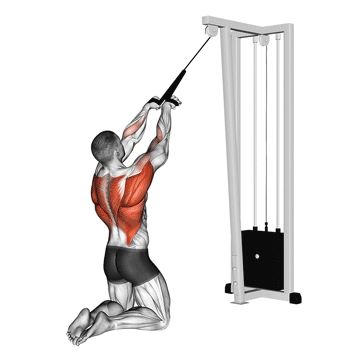
How To Do
- Set the cable up at a high point with the rope attachments
- Take a step back and get onto your knees facing the cable machine, then grab the rope with both hands using an overhand grip.
- Starting with your arms stretched out and away, pull back through your elbows until your hands are just in front of your shoulders
- Don’t lean backward to pull the weight towards you.
- Slowly return to the starting position. Repeat for desired reps.
13. One-Arm Lat Pulldown
One study has showed that performing a pulling exercise with the arms raised above the head is more effective in selectively strengthening the rhomboid muscle.
The lat pulldown is an exercise used to build back muscles. It is a great back exercise that fitness trainers widely use to build bigger lats.
This isolating exercise focuses on the back muscles without tiring the biceps.
Targeting your back muscles is important to help with proper posture and ease pulling movements.
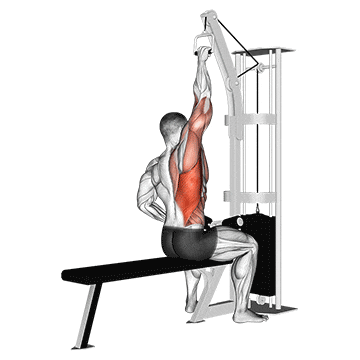
How To Do
- Take an overhand grip, hands slightly wider than shoulder-width apart, and sit on the machine seat. Lock your knees under the support pads.
- Keep your upper back straight, pull the bar down, and bring it to your chest.
- As you pull down, squeeze your shoulder blades together and feel your back muscles contracting.
- Use your upper lats to perform this movement; use the arms as a lever between the bar and the lats.
- Now, release the bar with controlled motion and stretch your lats as much as possible.
- Your reps should be slow and controlled to make the most of this move.
14. Seated Cable Row
The Seated Cable Rows are a fundamental horizontal pulling exercise. It’s a compound movement that effectively targets the entire back musculature.
The most effective way to exercise the rhomboid muscles is to squeeze shoulder blades together.
You can do it using different attachments.
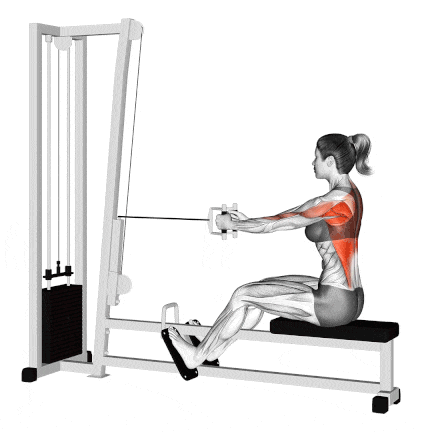
How To Do
- Sit on a seated cable pulley rowing machine with legs slightly bent and feet supported against the crossbar.
- Hold on to the handles with your arms extended and your back stretched.
- Pull the handles to come as close to the lower chest/abdomen as possible.
- Pause briefly when the handles are close to the chest and squeeze your rhomboid muscles, bringing the scapulae closer.
- Slowly return the handle to the starting position.
- Keep your upper back stationary; don’t move back and forth.
15. V-Grip Lat Pulldown
The V grip lat pulldown primarily targets the lats; you will also notice a fair amount of bicep and middle back activation.
The back is a muscle group that requires some variation. To maximise back muscle growth, experiment with several different angles and hand positions.
This is the perfect exercise to add to your rhomboid workout collection.
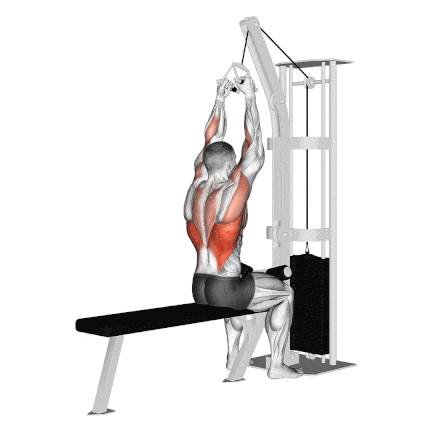
How To Do
- Attach a V handle to the high pulley of a lat-pulldown station.
- Grab the handles with your palms facing each other and position yourself on the seat with your knees under the pads.
- Keep your upper back straight, pull the V handle down, and bring it up to the chest.
- As you pull down, squeeze your shoulder blades together and feel your back muscles contracting.
- Perform this movement using your upper lats and use the arms merely as a lever between the handle and lats.
- Now, release the bar with controlled motion and stretch your rhomboids as much as possible.
16. Cable Twisting Standing Row
The cable back exercise involves numerous muscles and requires you to rotate slightly at the waist. Because it is unilateral, you must engage your core throughout the movement.
Besides being a great back exercise, this movement also works your hips, glutes, and other lower body muscles.
I enjoy this exercise because I feel that my rhomboid is thoroughly trained after doing it.
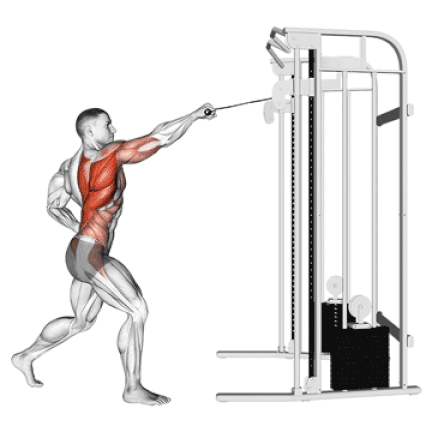
How To Do
- Attach a single grip handle to an elbow-high cable pulley.
- Step back and get into a staggered stance, knees slightly bent.
- Your arm should be out straight, and your waist should be rotated towards the cable.
- Keep your elbow close to your body, pull back towards your waist, and rotate your waist in the same direction.
- Pause briefly at the movement’s top, then slowly return to the starting position. Repeat desired reps.
- Your reps should be slow and controlled to make the most of this move.
17. Bent Over Rows with Resistance Bands
Bent-over rows are one of the best back exercises as they target many muscles simultaneously.
The primary mover here is the latissimus dorsi. This muscle will also work your entire back, including your trapezius, rhomboids, and deltoids.
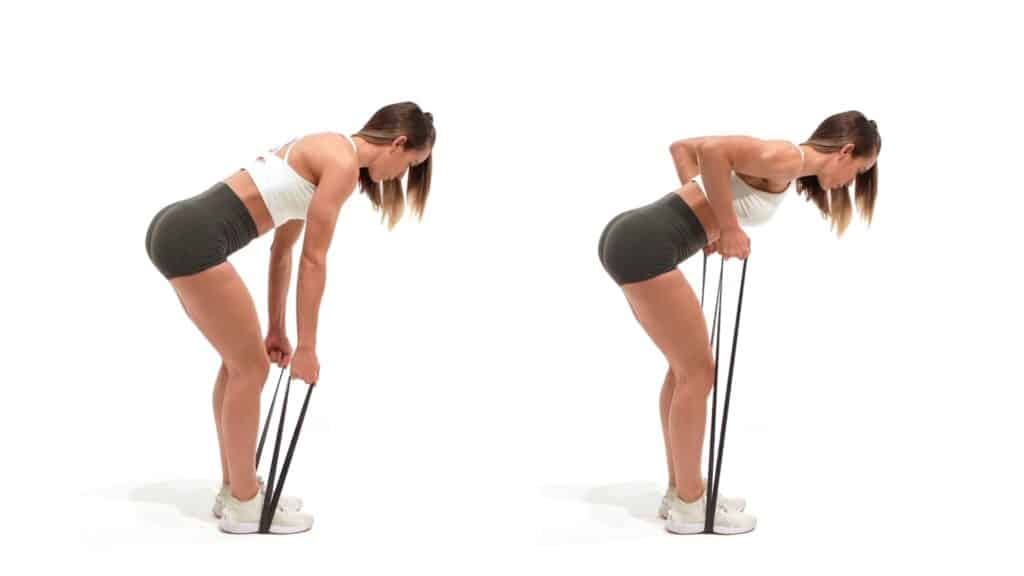
How To Do
- Stand on a resistance band, bending forward slightly, and hold both handles just under your knees.
- Keep your back flat and arms straight.
- Leading with your elbows, pull the handles of the resistance band back.
- Hold this contraction and slowly release it to the starting position.
18. Resistance Bands Lats Pulldown
The resistance band lat pulldown can be done anywhere, so it’s a good option for home workouts or while travelling.
It is a compound exercise that engages multiple muscle groups of the back, specifically the latissimus dorsi (lats) and teres major.
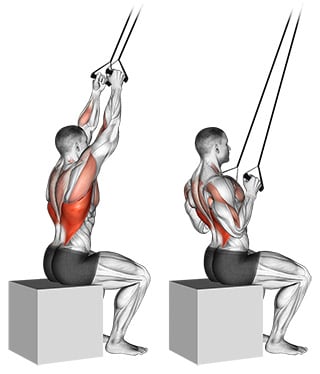
How To Do
- Attach the resistance band to a sturdy anchor point above your head, such as a door frame.
- Stand facing the anchor point and grasp the resistance band with an overhand grip.
- Step back to create tension in the band. Engage your core, and lean back slightly.
- Pull the band down towards your chest. Squeeze your shoulder blades together at the end of the movement.
- Slowly release the tension and return to the starting position.
19. Resistance Band Seated Row
The seated row with resistance bands targets the traps (lower), latissimus dorsi, rhomboids, rear delts, and biceps.
It will also work your erector spinae, as you need your lower back to stabilize your movement. Overall, this is an excellent movement for your mid-back.
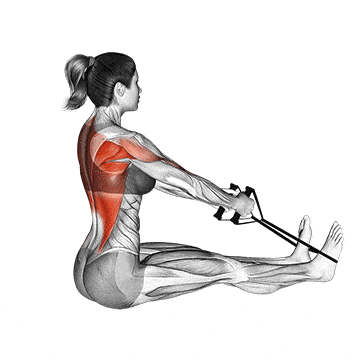
How To Do
- Sit on the floor with your legs extended. Loop the resistance band around the soles of your feet and hold one end in each hand.
- Keep your posture erect and your lower back slightly arched.
- Keep your elbows close to your sides and slowly pull the handles to your lower abdomen,
- As the handles touch your body, squeeze your shoulder blades together.
- Then, reverse direction and slowly return to the start position.
20. Resistance Bands Pull Apart
This movement can be done on shoulder day, as it targets the rear delts. However, we also like to hit it on a back day as the rear delts often need to double the weekly work.
The reverse fly with bands will work your rhomboids, rear delts, and traps. It’s a great upper-back exercise.
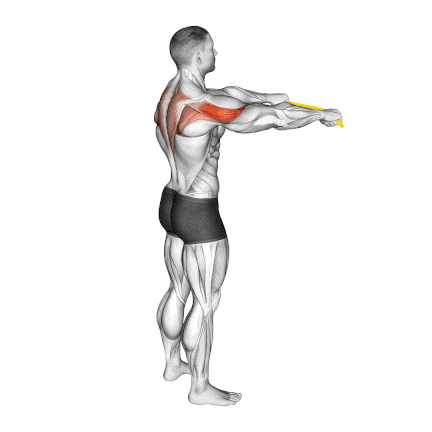
How To Do
- Stand with your feet shoulder-width apart. Keep your knees bent.
- Hold the exercise band before you with your hands slightly lower than your shoulders.
- Keep your elbows slightly soft to avoid hyperextending the joint.
- Pull the band apart and squeeze the shoulder blades together to open the arms to either side.
- Return to start and repeat, keeping tension on the band the entire time.
Workout Plan and Techniques To Train Rhomboid Muscles
Of course, the number of sets and reps will be determined based on your fitness journey, but here is a great starting point:
According to the latest scientific evidence, 12–20 weekly sets per muscle group may optimize muscle growth.
- Beginners: ~10 sets per week.
- Intermediate: ~15 sets per week.
- Advanced: ~20 sets per week.
The best rep ranges and loads to work with.
- For muscle endurance: Aim for 15-20+ reps with moderate resistance.
- For muscle hypertrophy (increased muscle size): Aim for 3-4 sets of 8-12 reps, with a moderate to heavy resistance.
It is always best to start with fewer reps and sets and gradually increase as your strength improves.
Beginner Rhomboid Workout Plan
| Exercises | Sets | Reps |
|---|---|---|
| I, Y, T, W | 4 | 12-15 |
| Bent Over Raise | 4 | 8-12 |
| Barbell Rows | 3 | 8-10 |
Bodyweight Rhomboid Workout Plan
| Exercises | Sets | Reps |
|---|---|---|
| Inverted Row | 4 | 8-12 |
| Prone Y-T-W Raises | 4 | 6-8 |
| Scapular Push-Ups | 3 | 8-12 |
| Band Pull-Aparts (Optional) | 4 | 10-15 |
What is the Rhomboid Muscle
The rhomboids comprise two muscles, the rhomboid minor and the larger rhomboid major.
The rhomboids are rhombus-shaped and are used to pull the shoulder blades together.
The rhomboid muscles are located on your upper back underneath the trapezius muscle. These muscles diagonally connect your spine (cervical and thoracic vertebrae) to your shoulder blades (scapulas).
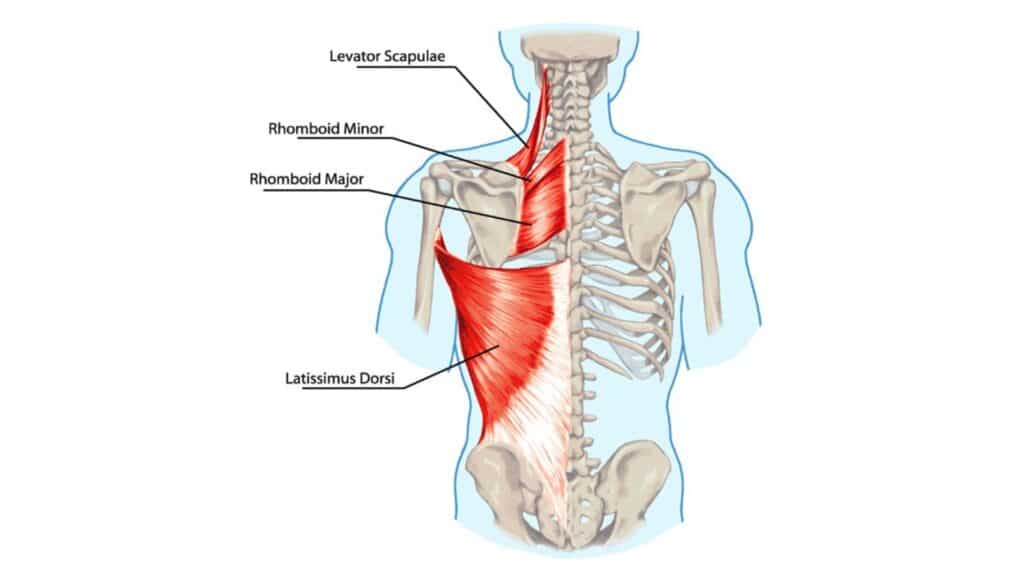
The Rhomboid Major is thin and flat and twice as wide as the thicker Rhomboid Minor, which lies superior to it.
Although they sit pretty high up on the back, they are usually considered a “mid-back” exercise because that is where you will feel them when doing exercises that target the rhomboids.
Rhomboids are superficial muscles, meaning they are close to the skin’s surface. However, they lie deep in the trapezius muscle of the upper back, and they are dominated by the almighty latissimus dorsi (lats) on the sides.
So, seeing the rhomboids is almost impossible unless you look at a well-defined individual with low body fat.
Function of the Rhomboid Muscle
- Adduct the scapula: That means pulling them toward each other. If you can imagine attempting to hold a pencil between your shoulder blades, you can know scapular adduction and feel your Rhomboids contracting.
- Downward rotate the scapula: You get a feel for the downward rotation of the scapula on a typical lat pulldown. As you pull the bar down, the inferior angle of the scapula rotates from out by your armpit back towards the spine.
- Another important function of the Rhomboids (along with the serratus anterior and the pectorals minor) is keeping your scapula against the rib cage.
FAQs
1. What causes weak rhomboids?
Rhomboid issues can be caused by
- Incorrect or poor posture
- Extended periods of sitting
- Overhead activities such as reaching for high shelves and
- Carrying heavy backpacks (especially over just one shoulder)
2. Rhomboid Exercises For Posture
Do you slouch and experience pain in your upper back? This could be caused by a weakness or an imbalance in your Rhomboids. Your rhomboid muscle is located in the upper back.
This muscle connects the shoulder blades to the rib cage and spine, and it is key to good posture.
Rhomboid exercises will help you stabilise your mid-back and strengthen your rhomboids.
Bodyweight Rhomboid exercises
- I, Y, T, W
- Inverted Row
- Scapular Push-Ups.
Dumbbell Rhomboid exercises
- Bent over Dumbbell Lateral Raise
- Lying Dumbbell Rear Delt Row
- Bent Over Row.
Resistance Band
- Single Arm Row with Resistance Bands
- Lat Pulls With Resistance Bands
- Standing Reverse Fly with Resistance Bands
3. Rhomboid exercises for kyphosis
Kyphosis, also known as round back or hunchback, is a condition in which the spine in the upper back has an excessive curvature.
The spine naturally curves in the neck, upper back, and lower back to help absorb shock and support the head’s weight. Kyphosis occurs when this natural arch is larger than normal.
Other potential causes of kyphosis include:
- Aging, especially if you have poor posture
- muscle weakness in the upper back
- arthritis or other bone degeneration diseases
- osteoporosis, or the loss of bone strength due to age
Rhomboid kyphosis exercises help train the upper back, strengthen the muscles, increase bone density, and improve posture.
References
- Fennell J, Phadke CP, Mochizuki G, Ismail F, Boulias C. Shoulder Retractor Strengthening Exercise to Minimize Rhomboid Muscle Activity and Subacromial Impingement. Physiother Can. 2016;68(1):24-8. doi: 10.3138/ptc.2014-83. PMID: 27504044; PMCID: PMC4961314.
- Fennell J, Phadke CP, Mochizuki G, Ismail F, Boulias C. Shoulder Retractor Strengthening Exercise to Minimize Rhomboid Muscle Activity and Subacromial Impingement. Physiother Can. 2016;68(1):24-8. doi: 10.3138/ptc.2014-83. PMID: 27504044; PMCID: PMC4961314.
- Yoo WG. Effects of pulling direction on upper trapezius and rhomboid muscle activity. J Phys Ther Sci. 2017 Jun;29(6):1043-1044. doi: 10.1589/jpts.29.1043. Epub 2017 Jun 7. PMID: 28626320; PMCID: PMC5468195.
- Smith J, Padgett DJ, Kaufman KR, Harrington SP, An KN, Irby SE. Rhomboid muscle electromyography activity during 3 different manual muscle tests. Arch Phys Med Rehabil. 2004 Jun;85(6):987-92. doi: 10.1016/s0003-9993(03)00618-x. PMID: 15179655.
- Farrell C, Kiel J. Anatomy, Back, Rhomboid Muscles. StatPearls [Internet]. 2021 Jul 26.

Manish is a NASM-certified fitness and nutrition coach with over 10 years of experience in weight lifting and fat loss fitness coaching. He specializes in gym-based training and has a lot of knowledge about exercise, lifting technique, biomechanics, and more.
Through “Fit Life Regime,” he generously shares the insights he’s gained over a decade in the field. His goal is to equip others with the knowledge to start their own fitness journey.
